Bimetallic radiators: design features, choice, dimensions,
Manufacturers began to combine metals for a long time to increase the efficiency of heating devices. So bimetallic batteries have become particularly popular in recent years. This is facilitated by a wide range of sizes; you can find both 800-mm bimetallic heating radiators and small devices with a center distance of about 30 cm.
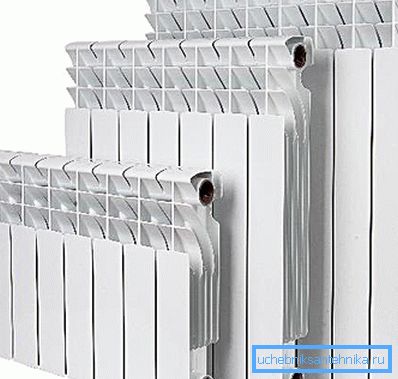
Design features
A key feature of any bimetallic radiator is the use of 2 different metals in the design.
Depending on which metal was used, it is possible to distinguish such types of batteries as:
- steel + aluminum. This can be considered a budget option, the manifold pipes are made of steel, which gives the radiator good strength;
Note! Such devices are particularly sensitive to the composition of the coolant. Although steel is processed from the inside for protection, but the durability of this type of battery is still lower than when using other metals.
- copper + aluminum. In terms of durability, this is an excellent option, and thanks to the use of non-ferrous metals, corrosion does not threaten the collector tubes.

The design in both cases remains the same - the collector tubes form a framework on which aluminum fins are pressed. The coolant passes through the tubes, heats them and the heat quickly spreads over the entire area of the fins.
Modern bimetallic radiators heat the room not only due to direct heat transfer, but also due to convection. That is why they have such a shape, thanks to special guides cool air from below enters the radiator, heats there and exits through the upper part of the heater.

Note! For the fins, not only aluminum can be used, but other metals as well. But in terms of cost / efficiency, it is aluminum that is preferable to other metals.
Does this design have any advantages?
Bimetal heating radiators are more difficult to manufacture than conventional ones, and this affects the cost.
But this is justified, because as a result, the buyer gets a solid set of advantages compared with the classic cast iron battery:
- the heater warms up very quickly (although it is not very important when heating the house, but it is worth mentioning it);
- in case of poor quality of the heat carrier, you should not worry about corrosion of the collector tubes (when using copper-aluminum models);
- in the heating system using bimetallic radiators, a much smaller amount of coolant will be used than when installing conventional heating devices;
- If you compare the same thermal power as a conventional cast iron battery and a bimetallic one, then it turns out that the bimetallic radiator is several times easier, so you can install all the bimetallic heating radiators yourself without any help;
- The metals used are quite plastic, so that hydraulic shocks in the heating system will not cause the appearance of microcracks. Yes, and installing a random blow will not cause a leak in the future;
- due to the developed finning, the surface area of such a radiator is higher than that of the cast-iron heater. That is why its heat transfer is about 1.5-2.0 times higher;

- durability reaches 25 years, it is, of course, less than that of cast iron, but also quite a lot. In addition, this is the battery life stated by the manufacturer, in reality they can work for 30-40 years.
Significant disadvantages of the combination of metals in the design of the battery is almost devoid of.
You can select only:
- the cost, nevertheless, the price of such a battery will be 2 times higher than the usual cast iron;
- If you try to save money and purchase a model with a steel collector, then when you drain water from the system for the summer, the corrosion of steel can significantly reduce the service life of the device.
Read more about choosing and installing bimetallic radiators.
The choice of batteries for the home is generally not an easy task, and in the case of bimetallic heating devices one has to take into account a number of additional nuances, for example, the diameter of the vertical channels of the collector tubes.
What to look for when choosing
Regardless of what kind of battery is chosen, when choosing, you need to pay attention to such parameters as:
- maximum allowable temperature of the coolant. Bimetallic heaters are usually designed for a maximum water temperature of 110? C, with the maximum working pressure depending on the manufacturer. For example, Global radiators can withstand a pressure of 35 bar, while the Royal thermo is only 20;
- then you need to know the dimensions of the battery (more on this below);
- the documentation also indicates the thermal capacity of the section; this information will help you know if there is enough battery power to heat the house;

Note! Heat output is indicated for a specific flow and return temperature. If the temperature of the coolant at the entrance and exit of the battery is different, then the heat transfer must be recalculated.
- Well, the appearance plays value. In principle, all modern batteries look stylish and modern, if you wish, you can purchase colored bimetallic radiators for heating. Factory painting is usually very reliable, so it is better to overpay for a color other than white than to paint the radiator yourself.
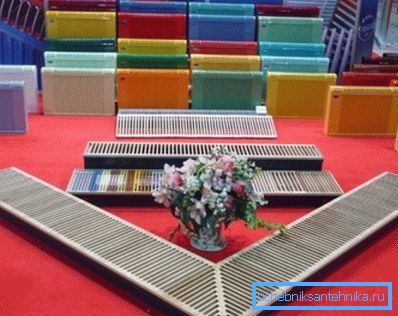
Dimensions of radiators
The dimensions of the radiators include the depth, full height and width of the device. In addition, you need to take into account the center distance. Sometimes the distance between the axles can be called the distance between the centers of the nipple holes.
Usually, the marking of the heating device already indicates the center distance, and the total height of the device is 5–7 cm higher than this value. The distance between the axes of bimetallic radiators varies in the range of 200-800 mm, but the most popular models are in the range of 300-550 mm.

Small height heating devices suitable for country cottages with large windows. Batteries of ordinary height would look ridiculous under such conditions and would block the view. In order to keep the heat output at the right level, the width of low batteries is larger than that of ordinary batteries, they are usually placed not in the niche under the window, but just against the wall, thanks to which nothing interferes with the heat transfer.
Heating bimetallic radiator must be installed in compliance with the general rules for the installation of heaters:
- the total height is selected taking into account the height of the niche under the window. Gaps of about 8 cm below and above the surface of the battery should be provided;
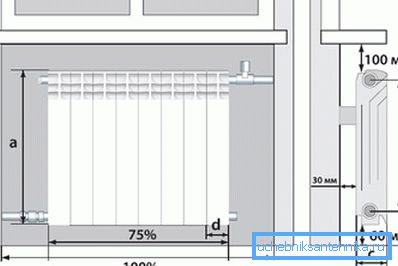
Note! From the upper part of the radiator, the distance to the battery can be increased, this will only improve convection, but the gap to the floor should not exceed 10-12 cm. Otherwise, the air near the floor will hardly warm up and people in the room will be uncomfortable.
- When installing with your own hands, it is advisable to select a radiator with a center distance that corresponds exactly to the distance between the supply pipe and the return. At installation it will not be necessary to reduce / dilute the pipes.
Solid or sectional radiator to choose
Most bimetallic radiators are sectional. In such constructions, the connection of separate sections is provided by steel nipples with different threads. When the nipple rotates, the sections are pressed tightly against each other, and special gaskets provide additional tightness.
Such a modular design allows to unify the production. It’s enough for the manufacturer to produce sections of a certain size with a thermal power of about 200 watts. Then from these sections you can assemble a heating device of any power, it all depends on how many sections will be combined.
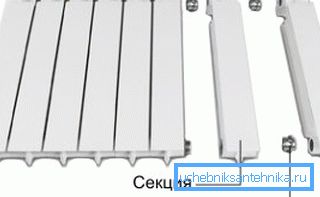
The disadvantage of such a battery can be considered an increased number of connections. Because of this, the working pressure is lower than that of solid radiators, and the risk of leakage when hydraulic hammer is higher.
Bimetallic monolithic heating radiators are a one-piece construction, the principle of operation is the same, just the collector is made of one-piece tubes, and aluminum fins are pressed on them. This allows you to increase the operating pressure in the system up to 100 bar (despite the fact that for sectional ones the upper limit is considered to be about 35 bar). For the rest of the parameters (such as durability, heat transfer, monolithic radiators are not inferior to sectional radiators).

Radiators of which manufacturer is better to choose
If in the first time after appearing on the market, some manufacturers made mistakes in production, now the majority of companies produce good quality batteries. The products of Rifar (Russia), Global and Sira (Italian manufacturers) are especially popular, MARS (South Korea) radiators showed themselves well.
Note! The term “bimetallic reinforced heating radiators” may be encountered, by this term is meant an ordinary device made of steel and aluminum, and mentioning the name “reinforced” in the name of the manufacturer simply emphasizes the strength of the structure.
In principle, the characteristics of most bimetallic batteries are comparable: working pressure 20-35 bar, coolant temperature 110-135? C, thermal power in the range of 150-200 watts. But when choosing attention should be paid to additional parameters, for example, the diameter of the vertical manifold tubes.
In old heating systems, it is not recommended to install heating devices with a vertical tube diameter of 6 mm (such models are in the list of products of Italian manufacturers). The lumen can simply be clogged, and the heat output of the heater will decrease.
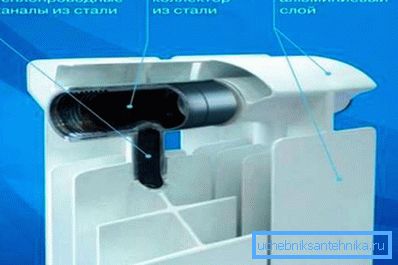
In principle, when choosing, it is enough to know the area of the room in order to approximately know the required thermal power of the battery and have a table with the characteristics of the radiators. This is enough to choose their own model.
As for the configuration, in addition to the radiator itself usually includes brackets for mounting. Installation instructions require fixing the heater on the wall, so they will come in handy. Given the low weight of the battery, floor brackets are used quite rarely and only in those cases when it is undesirable to make holes in the wall.
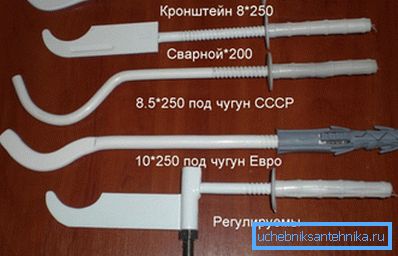
In conclusion
Even the cheapest bimetallic radiators have a sufficiently high thermal capacity, which allows them to be used in budget heating systems. The rest of the combination of metals of different types gives an excellent result - manufacturers managed to achieve high heat transfer of the heater, while reducing its weight. The durability at the same time remained at a high level.
The video in this article shows the process of assembling and installing a bimetallic radiator.